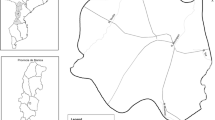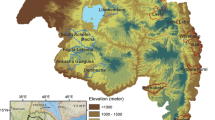Abstract
Endemic malaria in most of the hot and humid African climates is the leading cause of morbidity and mortality. In the last twenty or so years the incidence of malaria has been aggravated by the resurgence of highland malaria epidemics which hitherto had been rare. A close association between malaria epidemics and climate variability has been reported but not universally accepted. Similarly, the relationship between climate variability, intensity of disease mortality and morbidity coupled with socio-economic factors has been mooted. Analyses of past climate (temperature and precipitation), hydrological and health data (1961–2001), and socio-economics status of communities from the East African highlands confirm the link between climate variability and the incidence and severity of malaria epidemics. The communities in the highlands that have had less exposure to malaria are more vulnerable than their counterparts in the lowlands due to lack of clinical immunity. However, the vulnerability of human health to climate variability is influenced by the coping and adaptive capacities of an individual or community. Surveys conducted among three communities in the East African highlands reveal that the interplay of poverty and other socio-economic variables have intensified the vulnerability of these communities to the impacts of malaria.
Similar content being viewed by others
References
Africa Malaria Report (2003) http://www.rbm.who.int/amd2003/amr2003/amr_toc.htm
Conway D (2002) Extreme rainfall events and lake level changes in East Africa: recent events and historical precedents. In: Odada EO, Olago D (eds) The East African Great Lakes: limnology, palaeolimnology and biodiverity. Kluwer Academic Publ., Dordrecht, pp 64–92
Cohen AS, Kaufman L, Ogutu-Ohwayo R (1996) Anthropogenic threats, impacts and conservation strategies in the African Great, Lakes: a review. In: Johnson TC, Odada E (eds) The limnology, climatology and paleoclimatology of the East African Lakes. Gordon and Breach, Toronto, pp 575–624
Craig MH, Kleinschmidt I, Nawn JB, Le Suer D, Sharp BL (2004) Exploring 30 years of Malaria Case data in KwaZulu Natal, South Africa: part 1. The impact of climatic factors. Trop Med Int Health 9(12):1247–1257
De Savigny D, Mewageni E, Mayombana C, Masanja H, Minhaji A, Momburi D, Mkilindi Y, Mbuya C, Kasale H, Reid H, Mshinda H (2004a) Care seeking patterns in fatal malaria: evidence from Tanzania. Tanzania Essential Health Interventions Project (TEHIP), Rufiji Demographic Surveillance System, Tanzania, Ifakara Health Research and Development Centre, Tanzania, Tanzania Ministry of Health and International Development Research Centre (IDRC), Canada
De Savigny D, Mewageni E, Mayombana C, Masanja H, Minhaji A, Momburi D, Mkilindi Y, Mbuya C, Kasale H, Reid H, Mshinda H (2004b) Care seeking patterns in fatal malaria. Malar J 3:27. http://www.pubmedcentral.nih.gov/articlerender.fcgi?artid=514497
Fowler VG Jr, Lemnge M, Irare SG, Malecela E, Mhina J, Mtui S, Mashaka M, Mtoi R (1993) Efficacy of chloroquine on plasmodium falciparum transmitted at Amani, Eastern Usambara Mountains, North-East Tanzania: an area where malaria has recently become endemic. J Trop Med Hyg 6:337–345
Garnham PCC (1945) Malaria epidemics at exceptionally high altitudes in Kenya. The Br Med J 11:45–47
Githeko AK, Ndegwa W (2001) Predicting malaria epidemics in the Kenyan Highlands using climate data: a tool for decision makers. Global Change and Human Health 2:54–63
Githeko AK, Lindsay SW, Confaloniero UE, Patz JA (2000) Climate change and vector-borne disease: a regional analysis. Bull WHO 78(9):1136–1147
Githeko AK, Ayisi JM, Odada PK, Atieli FK, Ndenga BA, Githure IJ, Yan G (2006) Topography and malaria transmission heterogeneity in the western Kenya highlands: prospects for vector control. Am J Trop Med Hyg 5:107
Greenwood B (2004) Between hope and a hard place. Nature 430:926–927
Greenwood B, Mutabingwa T (2002) Malaria in 2002. Nature 415:670
Hastenrath S (1991) Climate and circulation of the tropics. Reidel, Dordrecht, p 455
Hay SI, Simba M, Busolo M, Noor AM, Guyatt HL, Ochola SA, Snow RW (2002) Defining and detecting malaria epidemics in the highlands of Western Kenya. Emerg Infect Dis 8:555–562
Hirsch RM (1982) A comparison of four stream flow record extension techniques. Water Resour Res 18(4):1081–1088
Hoekstra D, Corbett J (1995) Sustainable agricultural growth for highlands of East Africa and Central Africa: prospects to 2020. Paper presented at the ecoregions of the developing world: a lens for assessing food, agriculture and the environment to the year 2020. Organized by the International Food Policy Research Institute, Washington
Indeje M, Semazzi FHM, Ogallo LJ (2000) EÑSO signals in East African rainfall seasons. Int J Climate 20:19–26
IPCC 4th Assessment Report (2007) Contribution of working groups I, II, and III. In: Core writing Team, Pachauri RK, and Reisinger A (eds) IPCC Geneva, Switzerland, p 104
Kemp WP, Burnell DG, Everson DO, Thomson AJ (1983) Estimating missing daily maximum and minimum temperatures. J Am Meteorol Soc 22:1587–1593
Khaemba BM, Mutani A, Bett MK (1994) Studies of anopheline mosquitoes transmitting malaria in a Newly Developed Highland Urban Area: a case study of Moi University and its environs. East Afr Med J 3:159–164
Kilian AHD, Langi P, Talisuna A, Kabagambe G (1999) Rainfall pattern, El Nino and Malaria in Uganda. Trans R Soc Trop Med Hyg 93:22–23
King’uyu SM, Ogallo LA, Anyamba EK (2000) Recent trends of minimum and maximum surface temperatures over Eastern Africa. J Climate 31:2876–2886
Lepers JP, Deloron P, Fontenille D, Coulanges P (1988) Reappearance of falciparum malaria in Central Highland Plateaux of Madagascar. Lancet 12(1):585–586
Lindblade KA, Walker ED, Onapa AW, Katunge J, Wilson ML (1999) Highland Malaria in Uganda: prospective analysis of an epidemic associated with El Nino. Trans R Soc Trop Med Hyg 93:480–487
Lindblade KA, Walker ED, Onapa AW, Katunge J, Wilson ML (2000) Land use change alters malaria transmission parameters by modifying temperatures in a highland Area of Uganda. Trop Med Int Health 5(4):263–274
Lindsay SW, Martens WJM (1998) Malaria in the African Highlands: past, present and future. Bull WHO 76:33–45
Loevinsohn ME (1994) Climate warming and increased malaria in Rwanda. Lancet 343:714–748
Malakooti MA, Biomndo K, Shanks GD (1998) Reemergence of epidemic malaria in the highlands of Western Kenya. Emerg Infect Dis 4:671–676
Martens P, Kovats RS, Nijhof S, de Vries P, Livermore MTJ, Bradley DJ, Cox J, McMichael AJ (1999) Climate change and future populations at risk of malaria. Glob Environ Change 9:S89–S107
Matola YG, White GB, Magayuka SA (1987) The changed pattern of malaria endemicity and transmission at Amani in the Eastern Usambara Mountains, North-Eastern Tanzania. J Trop Med Hyg 3:127–134
McMichael AJ, Hames A, Scooff R, Covats S (eds) (1996) Climate change and human health: an assessment. Prepared by a Task Group on behalf of the World Health Organization, the World Meteorological Organization and the United Nations Environment Programme, Geneva
Mocumbi P (2004) Plague of my people. Nature 430:925
Mouchet J, Manuin S, Sircoulon S, Laventure S, Faye O, Onapa AW, Carnavale P, Julvez J, Fontenille D (1998) Evolution of malaria for the past 40 years: impact of climate and human factors. J Am Mosq Control Assoc 14:121–130
Munga S, Minakawa N, Zhou G, Mushinzimana E, Barrack OO, Githeko AK, Yan G (2006) Association between land cover and habitat productivity of malaria vectors in Western Kenyan highlands. Am J Trop Med Hyg 74:69–75
Mutemi JN (2003) Climate anomalies over eastern Africa associated with various ENSO evolution phases. PhD thesis, University of Nairobi, Kenya
Nicholson SE (1996) A review of climate dynamics and climate variability in Eastern Africa. In: Johnson TC, Odada EO (eds) The limnology, climatology and palaeoclimatology of East African Lakes. Gordon and Breach, Australia, pp 25–56
Nuwaha F (2002) People’s perceptions of malaria in Mbarara, Uganda. Trop Med Int Health 7(5):462–470
Olago D, Marshall M, Wandiga SO, Opondo M, Yanda PZ, Kangalawe R, Githeko A, Downs T, Opere A, Kabumbuli R, Kirumira E, Ogallo L, Mugambi P, Apindi E, Githui F, Kathuri J, Olaka L, Sigalla R, Nanyunja R, Baguma T, Achola P (2007) Climatic, socio-economic and health factors affecting human vulnerability to cholera in the Lake Victoria Basin, East Africa. Ambio 36(1):1–10
Ogallo L et al (1989) The spatial and temporal patterns of the East African rainfall derived from principal components analysis. Int J Climate 9:145–167
Patz JA, Strzepek K, Lele S, Hedden M, Greene S, Noden B, Hay SI, Kalkstein L, Beier JC (1998) Predicting key malaria transmission factors, biting, and entomological inoculation rates, using modeled soil moisture in Kenya. Trop Med Int Health 3:818–827
Patz JA, Hulme M, Rosenzweig C, Mitchell TD, Goldberg RA, Githeko AK, Lele S, McMichael AJ, Le Sueur D (2002) Regional warming and malaria resurgence. Nature 420:627–628
Roberts JMD (1964) Control of epidemic malaria in the highlands of Western Kenya, part I before the campaign. J Trop Med Hyg 61:161–168
Ropelewski CF, Halpert MS (1987) Global and regional scale precipitation patterns associated with the El Niño/Southern Oscillation. Montr Weather Review 115:1606–1626
Sachs J, Malaney P (2002) The economic and social burden of malaria. Nature 415:680–685
Some ES (1994) Effects and control of highland malaria epidemic in Uasin Gishu District, Kenya. East Afr Med J 71:2–8
Spielman A, Seiguer E (2003) Documentation of the socio-economic impact of malaria epidemics in Africa. WHO/ Final Report. http://www.who.int/malaria/cmc_upload/0/000/016/663/econmalreport29May.pdf
Tabony RC (1983) The estimation of missing climatological data. J Climatol 3:297–314
World Health Organisation (WHO) (1996) World health report: fighting diseases, fostering development. WHO, Geneva
World Health Organisation (WHO) (2005) World Malaria Report 2005. Geneva, Switzerland: WHO
WHO (2002) Roll back malaria. www.rbm.who.int
WHO (2003) Methods for assessing human health vulnerability and public health adaptation to climate change. Health and Global Environmental Change Series No. 1. WHO Regional Office for Europe, Copenhagen
World Bank (1996) Staff Appraisal Report for the Lake Victoria Environmental Management Project, Report No. 15429-AFR, Washington
Zhou G, Minakawa N, Githeko AK, Yan G (2004) Association between climate variability and malaria epidemics in the East African highlands. Proc Natl Acad Sci 101:2375–2380
Zhou G, Manikawa N, Githeko A, Yan G (2005) Climate variability and malaria epidemics in the highlands of East Africa. Trends in Parasitology 12(2):54–56
Author information
Authors and Affiliations
Corresponding author
Rights and permissions
About this article
Cite this article
Wandiga, S.O., Opondo, M., Olago, D. et al. Vulnerability to epidemic malaria in the highlands of Lake Victoria basin: the role of climate change/variability, hydrology and socio-economic factors. Climatic Change 99, 473–497 (2010). https://doi.org/10.1007/s10584-009-9670-7
Received:
Accepted:
Published:
Issue Date:
DOI: https://doi.org/10.1007/s10584-009-9670-7




